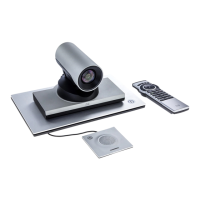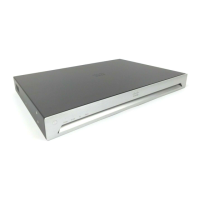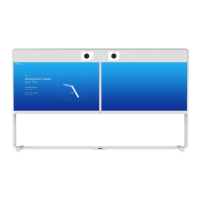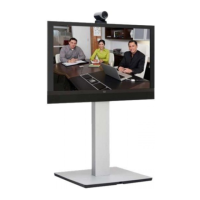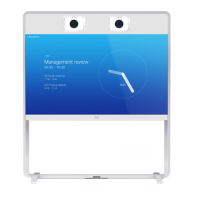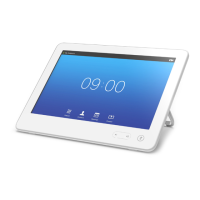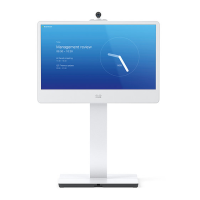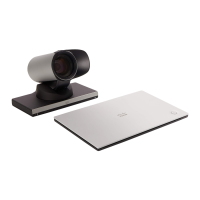D15363.05 Cisco TelePresence DX70 and DX80 API Reference Guide CE9.2, NOVEMBER 2017.
Copyright © 2017 Cisco Systems, Inc. All rights reserved. 35
Cisco TelePresence DX70 and DX80
API Reference Guide
Feedback from codec over HTTP
You can get the device to post http feedback messages
(also known as webhooks) on changes to the API state, e.g.
statuses, events and configuration updates. The HTTP Post
feedback messages will be sent to the specified ServerURL.
You can choose between events being posted in either XML
or JSON format. You can subscribe to changes on multiple
parts of the API by register up to 15 different feedback
expressions.
Registering for feedback
The command for registering is
xCom mand HttpFeedback
Register
. The syntax for this command and its arguments are
described in this section.
HttpFeedback Register syntax:
xCommand HttpFeedback Register
FeedbackSlot: <1..4>
ServerUrl(r): <S: 1, 2048>
Format: <XML/JSON>
Expression: <S: 1, 255>
Expression: <S: 1, 255>
Expression: <S: 1, 255>
Expression: <S: 1, 255>
Expression: <S: 1, 255>
Expression: <S: 1, 255>
Expression: <S: 1, 255>
Expression: <S: 1, 255>
Expression: <S: 1, 255>
Expression: <S: 1, 255>
Expression: <S: 1, 255>
Expression: <S: 1, 255>
Expression: <S: 1, 255>
Expression: <S: 1, 255>
Expression: <S: 1, 255>
HttpFeedback Register arguments:
FeedbackSlot: The codec can register up to 4 slots of servers
requesting HTTP feedback. Set the registering to one of them.
NOTE: Avoid using FeedbackSlot 3 in an environment where
Cisco TelePresence Management Suite (TMS) is used as TMS
uses this feedback slot to register its expressions.
ServerUrl: The URL to the HTTP server where you want the
codec to post the HTTP feedback messages to.
Format: Set the format for the feedback from the HTTP server
to XML or JSON.
Expression 1-15: The XPath expression specifies which parts
of the Status, Configuration or Event documents are monitored.
You can have from 1 to 15 XPath expressions
Register the expressions you want to receive feedback on.
See the “Feedback mechanism” on page 31 section for
more information about the expression formats.
Example: Registering feedback on configuration changes,
disconnect events and call status changes.
POST /putxml HTTP/1.1
Content-Type: text/xml
<Command>
<HttpFeedback>
<Register command=”True”>
<FeedbackSlot>1</FeedbackSlot>
<Ser verUrl >htt p://127.0.0.1/
myhttppostscripturl</ServerUrl>
<Format>XML</Format>
<Expression item=”1”>/Configuration</
Expression>
<Expression item=”2”>/Event/
CallDisconnect</Expression>
<Expression item=”3”>/Status/Call</
Expression>
</Register>
</HttpFeedback>
</Command>
Feedback output
When the codec notifies the registered HTTP server about
changes, the body contains the same XML as when polling.
There is however one small difference. The root-node
contains an Identification node with children that specify the
codec from which the notification originated. This means that
you can handle multiple codecs with a single HTTP server URI.
Example: Audio volume changed.
<Configuration xmlns=”http://www.company.com/XML/
CUIL/2.0”>
<Identification>
<SystemName>My System Name</SystemName>
<M ACAdd ress>00:00:de:ad:be:ef</M ACAdd ress>
<IPA d d r e ss>192.168.1.100</IPAd d ress>
<ProductType>Cisco Codec</ProductType>
<ProductID>Cisco Codec DX80</ProductID>
<SW Versio n > C E8.3.0.199465</SW Ve rsio n >
<H W B oa rd >101401-5 [08]</H W B o a rd >
<SerialNumber>PH0000000</SerialNumber>
</Identification>
<Audio item=”1”>
<Volume item=”1”>60</Volume>
</Audio>
</Configuration>

